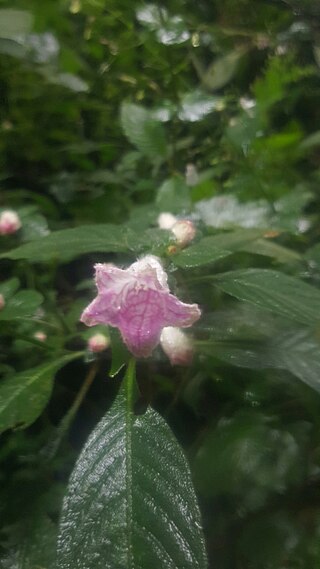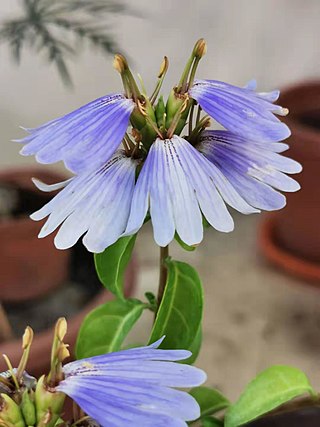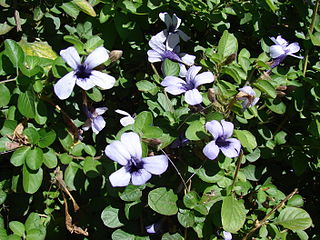
Senecio is a genus of flowering plants in the daisy family (Asteraceae) that includes ragworts and groundsels.

Acanthaceae is a family of dicotyledonous flowering plants containing almost 250 genera and about 2500 species. Most are tropical herbs, shrubs, or twining vines; some are epiphytes. Only a few species are distributed in temperate regions. The four main centres of distribution are Indonesia and Malaysia, Africa, Brazil, and Central America. Representatives of the family can be found in nearly every habitat, including dense or open forests, scrublands, wet fields and valleys, sea coast and marine areas, swamps, and mangrove forests.

Tanacetum is a genus of about 160 species of flowering plants in the aster family, Asteraceae, native to many regions of the Northern Hemisphere. They are known commonly as tansies. The name tansy can refer specifically to Tanacetum vulgare, which may be called the common tansy or garden tansy for clarity. The generic name Tanacetum means 'immortality' in Botanical Latin, since tansy was once placed between the burial sheets of the dead to repel vermin.

Ruellia is a genus of flowering plants commonly known as ruellias or wild petunias. They are not closely related to petunias (Petunia) although both genera belong to the same euasterid clade. The genus was named in honor of Jean Ruelle (1474–1537), herbalist and physician to Francis I of France and translator of several works of Dioscorides.

Dicliptera is a genus of flowering plants in the bear's breeches family, Acanthaceae. It includes 223 species native to the tropics and subtropics worldwide. Well-known synonyms include Peristrophe and Dactylostegium.

Lepidagathis is a genus of flowering plants in the family Acanthaceae. It includes 151 species native to the tropics of the Americas, sub-Saharan Africa, south and southeast Asia, southern China, Malesia, and New Guinea.

The genus Asystasia belongs to the family Acanthaceae and comprises 59 species found in the tropics of Africa, Asia, Australia, and New Guinea. It includes the weedy species Asystasia gangetica.

Farsetia is a genus of flowering plants in the family Brassicaceae. It contains the following species:

Acanthopale is a plant genus of shrubs or subshrubs in the Acanthaceae plant family. The genus name is based on the classic Greek words for thorn ákantha and stake palum. Some species in the genus are cultivated as ornamental plants.

Anisotes is a genus of Afrotropical plants in the family Acanthaceae. The genus is morphologically similar to Metarungia, from which it differs mainly in the dehiscence of the fruit capsule, and the nature of the placenta. Placentas remain attached to the inner surface of fruit capsules in Anisotes.

Blepharis is a genus of plant in family Acanthaceae. It contains around 128 species found in seasonally dry to arid habitats from Africa through Arabia to Southeast Asia. In section Acanthodium, there are 13–15 species that use the C4 carbon fixation pathway. Phylogenetic analysis suggests that this pathway evolved up to three times independently in the genus over the last five million years.

Isoglossa is a genus of flowering plants in the family Acanthaceae. It includes 78 species native to tropical Africa, Yemen, the eastern Himalayas, southern China, Indochina, Peninsular Malaysia, Java, Sulawesi, the Lesser Sunda Islands, and New South Wales.

Pseuderanthemum is a genus of plants in family Acanthaceae with a pantropical distribution.

Rhinacanthus is a genus of plants in the family Acanthaceae. It includes 26 species native to tropical Africa and Asia, ranging across sub-Saharan Africa to Madagascar, the Indian subcontinent, Indochina, south-central China, Peninsular Malaysia, and the Philippines.

Sclerochiton is a genus of flowering plants in the family Acanthaceae. It includes 18 species native to tropical and southern Africa.

Crossandra is a genus of plants in the family Acanthaceae, comprising 54 species that occur in Africa, Madagascar, Arabia and the Indian subcontinent. Some species, especially Crossandra infundibuliformis, are cultivated for their brightly colored flowers.

Dyschoriste is a genus of flowering plants in the family Acanthaceae. It includes 98 species native to the tropics and subtropics of the Americas, sub-Saharan Africa, and southern Asia. Members of the genus are commonly known as snakeherb.
Stenandriopsis is a genus of flowering plants belonging to the family Acanthaceae. It includes 20 species native to tropical Africa and Madagascar. Molecular phylogenies have placed the Old World Stenandriopsis apart from New World Stenandrium, and the genus is accepted in a classification of the family Acanthaceae published in 2022.

Rungia is a genus of flowering plants belonging to the family Acanthaceae.


















